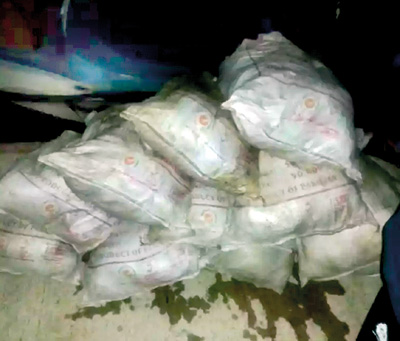News
One and a half month long op. led to seizure of the second largest heroin haul
The second largest haul of heroin seized in Sri Lanka, was detected by the Police Narcotic Bureau (PNB) officials in the seas off Beruwala last week. The 231 kilograms of heroin with an estimated street value of more than Rs. 2,778 million was believed to have been intended for transhipment via Sri Lanka.

The heroin haul suspected to have originated in Afghanistan and trafficked via Pakistan. Pic by Sarath Siriwardene
According to Police sources, the one and a half month long operation was coordinated between the Police Narcotic Bureau, Special Task Force, Sri Lanka Coast Guard and the Sri Lanka Navy. The United Nations Office on Drugs and Crime (UNODC) had assisted the PNB officials in carrying out the raid. The heroin is suspected to have originated in Afghanistan and transported via Pakistan.
SP Ruwan Gunasekera, the Police Spokesman said the heroin was seized as it was being trafficked into the country in a boat five nautical miles off Beruwala. Police had arrested two smugglers along with the haul and the owner of the boat.
The two suspects were detained for further questioning after being produced before the Colombo Chief Magistrate. They were named as, Mohammed Risvi (34) and Dilip Susantha (38) from Beruwala.
A police source who wished to remain anonymous revealed to the Sunday Times, that the captain of the apprehended trawler was long suspected to be a trafficker of narcotics. He is the owner of nine fishing vessels and is believed to have direct links to criminals in the Maldives, Seychelles and Mauritius.
The trawler had left Beruwala in the first week of October and had spent almost two months at sea. “This time frame had raised suspicions that the vessel may have been resupplied at sea and that it may have transferred more of its cargo to other smaller vessels or possibly to a commercial freighter heading to a foreign port of call” said the police source. “ Junior police officers of the PNB mounted surveillance along the coastline for more than a month and a half, in bad weather and with minimal facilities,” the police source explained. “It was refreshing to see the public support we received” he said. Vigilant citizens along the coast provided us with information and support to make this operation a success,” he pointed out.
The owner of the boat, the 44-year-old Dinayadura Dulip Samantha de Silva (44) also a resident of Beruwala is the brother of Dilip Susantha. He was arrested in Yatiyanthota by Police last Friday, after he had attempted to evade arrest by diving into the Kelani River. Rs.1.5 million in cash was found in his possession.
The PNB and other law enforcement agencies, with the support of the armed forces detected 103 Kilograms of heroin in Kalubowila last July and 15 million tablets of high strength Tramadol in September.
Trafficking of Afghan heroin on the “Southern Route” is expanding, with trafficking networks constantly changing the trafficking patterns on the maritime route said Shanaka Jayasekara, Programme coordinator for the Indian ocean region, The Global Maritime Crime Programme (GMCP) of the UNODC. The Global Maritime Crime Programme (GMCP) of UNODC has facilitated access to satellite vessel tracking information to the Sri Lanka Police Narcotics Bureau, Navy and Coast Guard to identify drug trafficking vessels. GMCP continues to help coastal states to develop dark-targeting capability using maritime domain awareness (MDA) information to counter illicit activity at sea.
In January, 928 kgs of seized cocaine valued at Rs. 16.7 billion was destroyed in public, with the President and Senior Government officials on site to witness it. The cocaine was destroyed by being exposed to a temperature of 1,300 centigrade in an incinerator in Puttalam.

